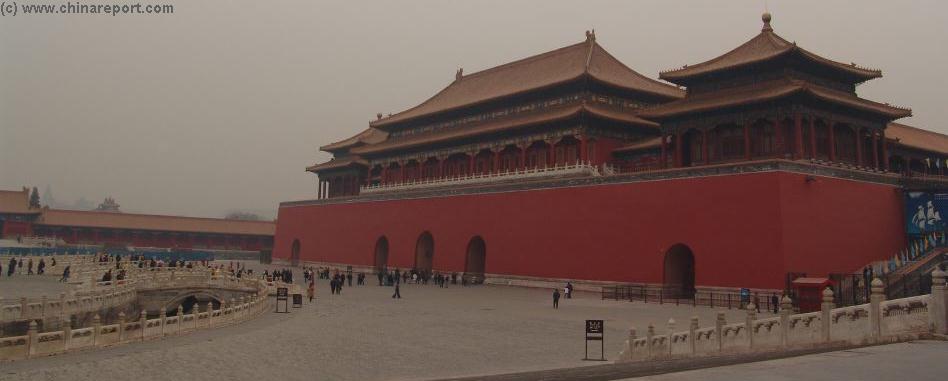Forbidden City, the Palace Museum in the Qing Dynasty
CAPTURE OF BEIJING AND COMING TO POWER OF THE MANCHU:
First rebuilt palace on 1 to 10 scale. Next 14 years rebuilt on original scale.
FIRES AT THE QING DYNASTY FORBIDDEN CITY:
Fire in 1679 cause by kitchen unit.
1683 rebuilt some previous destroyed areas
In 1735 Qianlong became emperor started a 60 years major restoration of Qugong.
Deep in the night of the 15th day of the 12th month in the 14Th year of the Reign of the Guangxu Emperor (Reign: 25 February 1875 – 14 November 1908), a night of howling wind, leaping flames lit up the night sky, while below dense smoke enveloped the Forbidden City and frantic shouts and cries arose from the black cloud, piercing the air. Such was the scene of the sensational fire at the Palace's Gate of Chastity (Zhendumen).
The nearby area had always been highly restricted because in proximity, to the left- and the right of the Gate of Chastity (Zhen Du Men) were quarters for the palace guards and nearby were a number of storehouses which were filled with priceless goods.
Due to the water shortage in the Palace and inadequate fire fighting equipment (which was not very sophisticated in China at the time) the fire that broke out that fateful night could not be contained until two days later. In the conflagration not only this entrance gate was lost to the fire, but also the highly important Gate of Supreme Harmony as well as the Gate of Genuine Virtue in the east. Altogether, the whole impressive and luxurious frontage of the central throne Hall had burned down to the ground. Some nearby storage houses were also reduced to ashes.
According to the Palace records, the fire turned out to have been caused by two palace guards on night duty, one Fu Shan and one Shuang Kui. After hanging an old hurricane lamp on a post behind the east gable of their quarters, they fell asleep. In the dead of night, the flames of the lamp leapt out of the funnel driven by the high winds. It set a wooden post on fire, which in turn ignited structures in all surrounding directions.
By the time the two sleepers woke up, it was too late. The Emperor Guangxu (and the real ruler, Empress-Dowager Cixi), hearing of the dreadful news, was none too pleased. In fact, with the Emperor possibly being the worst employer in the entire nation, the two guards were dealt with harshly. As a result of their dreadful mistake, they were hanged the very next dawn.
Although this satisfied the Emperor's anger somewhat, it did not make up for the fact that -in general- this fire seemed to be a very bad omen.
As it was the, the soaring fire at the Gate of Chastity occured just as preparations were underway for Emperor Guangxu's marriage, a ceremony of the highest importance, which in this case also marked to important coming of age of the young Emperor, thus releasing him from the control of the old and ultra-conservative Empress-Dowager, Cixi.
A fire in the Palace at such an important time, was taken to be an ill omen. It was thus, through the perception of feudal society and the magical traditional thoughts of the people, it was now thought that the marriage itself was ill-conceived. Arranged by the Empress-Dowager Cixi, the bride (later Empress Longyu) was Guangxu's own cousin, who on top of that was also three years his senior. The word at court was that she was not even that pretty and in fact rather plain looking. However, the arrangement was of huge political importance, as through the marriage it was assured that the future crown prince would be born from a lady of Cixi's Yehonala Clan, thus maneuvering the ruling Aisin-Gioro clan out of power. It would prove the move to end the Dynasty, and thus an ill omen was most appropriate. The courtiers obviously felt this way.
As the tales have it, the marriage did take place but the marriage was never consumated (for various reasons. Guangxu came to despise Longyu simply because she worked together with Cixi to control his powers. Later the Emperor Guangxu was imprisoned) and eversince the fire at the Gate of Chastity has been taken as a symbolic warning of the ill fate of this union.
By tradition, royal wedding processions were enter the Palace first through the Gate of Meridian (Wu Men) and then proceed onwards through the Gate of Supreme Harmony (Taihe Men). Now that there was only the black cinders reminding of the once proud Gate of Supreme Harmony, and there was clearly not enough time to rebuild it, a make-shift entrance had to be erected for Guangxu's wedding. It would look a lot less grandiose.
It was not until 1889, the 15th year of the reign of Guangxu that renovations on the three gates could begin.
In 1886 major fire destroyed main buildings. Rebuilding last for 20 years until 1906. Three major rebuilding projects.


